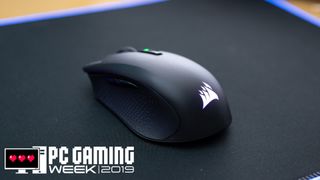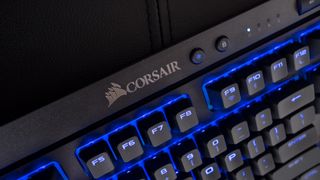
Corsair surprised us early in 2018 with its first wireless keyboard, the K63 Wireless, and while we rated it with a nearly perfect score in our review, we wanted the inside story behind it. So, we’ve traveled to Corsair headquarters in Fremont, California to hear the tale straight from the source.
Michael Grey, Senior Product Line Manager at Corsair, tells us that “what really got us started was the wireless technology, first of all, was it had gotten to the point of one millisecond latency."
“The technology had been around for a couple of years before we put the keyboard out there,” Grey explains. “But, the reason we launched when we did is because the 1ms wireless hadn't been tested and vetted properly.”

As with other wireless technology we’ve seen from Logitech and beyond, Corsair began its testing in anechoic chambers that basically absorb sound and any sort of electromagnetic waves. In this controlled environment, Corsair was able to figure out where the strongest wireless signal came from: 45 degrees to the right of the gaming keyboard’s center.
The company then took the keyboard for testing in its lab to see how various distances would affects signal strength. Grey’s team also introduced various home objects, such as routers or other wireless dongles, to add interference.
“We tested the Corsair K63 wireless in our own lab, which is really dirty with wireless signals, to come out with a product that we really feel felt comfortable with and that we could tell gamers, ‘look, this wireless now is as good as wired technology,’” Grey expounds. “It shouldn't be any different of a user experience to use this versus wired counterparts.”

Getting technical
The underlying wireless chip Corsair uses isn’t actually of its own making, but rather from a third-party supplier that Grey declined to name. However, Grey explains that Corsair works closely with its mystery supplier to customize it, put its own firmware and ‘secret sauce’ on the chip in order to optimize signal speed and integrity.
Get daily insight, inspiration and deals in your inbox
Get the hottest deals available in your inbox plus news, reviews, opinion, analysis and more from the TechRadar team.
“We really like the chipset that we use because it actually gives us Bluetooth capability, which other chip sets in the market don't provide that capability,” Grey says. “So, that gives us the unique potential to have three modes of connectivity in our products with Bluetooth, one millisecond 2.4GHz and even wired USB.”
Grey tells us that a greater amount of development went into fitting everything into its existing Corsair K63 platform, which was its smallest tenkeyless keyboard.
“We had to figure out how to fit a battery in there, how to design an antenna, where to put these added chip sets,” Grey illuminates. “And then, there's all sorts of challenges with a what capacity battery, how to maximize battery life. All the tricks that people who've been making wireless keyboards for a very long time know very well.”
“Quite frankly, it was a lot more work than anyone thinks,” he says. “Everyone sees it just like ‘oh, they just put a battery in it and wireless.’ No, no, no, no. It took a lot more than that. Especially, because all of these products were Corsair's first shot at wireless products. A lot of people don't get a necessarily good reception on their first wireless products because it's very complicated to do and it's fraught with issues.”

Next level hurdles
While the Corsair K63 Wireless was designed to be as fast as wired – and it actually is in our book – getting it to work just so, especially with the lighting, continues to be a challenge.
“When you're USB mode on any of our standard wired products; iCUE, our software, takes control and sends data back to the keyboard to control all of the lighting,” Grey explains. “On wireless, we're not able to do that because the packets [sent to the Corsair K63 Wireless have to be] so small.”
“Even though we're still able to send the data out quickly, it's receiving data [on the keyboard] that's a little more challenging,” he says.
What the team ultimately had to do was bake all of the lighting options into directly into the keyboard and the software only tells the K63 Wireless when to trigger it. Grey explains that this is one of the reasons why there isn’t any RGB lighting on its wireless keyboard – on top of the fact that it would draw three times more energy.
“RGB is always an opportunity – I mean, here we love RGB – to do in the future, but there's a few technology pieces that need to improve first before we're comfortable with that,” Grey promises.
“I've got some schools of thought on how that would be accomplished, but it wouldn't be the same as a wired keyboard where it's doing it what we call frame-by-frame,” he says. “So, every millisecond, it's sending out data on what to go play next. We wouldn't be able to do that. It would have to be a new, unique approach.”

An all wireless future?
Despite the challenges wireless technology introduces, Grey truly believes in a wireless future.
“I think you see it everywhere, that everyone is trying to figure out how to make everything go wireless,” Grey expounds. “Because wires are inconvenient and I think the future of everything is wireless.”
“We're in a society that values convenience, and throughout history,” he says. “If we can make something more convenient, and it works, great. Let's do it. Let's do it to everything, and wireless is going to be no different.”
Even on an esports level, Grey sees there being the potential of a wireless future especially when it can remove any interference for the highest level of play.
“Getting rid of the wire is actually a big thing because you no longer have drag it around,” Grey says. “[Even] if you use a mouse bungee, for instance, it can limit your mouse movement. [Wireless] just makes the experience a little bit cleaner. I mean, how would you like to go play a game of tennis with a cord strapped to your racket?”
“But again,” Grey warns, “we're just at the point where the wireless technology hit that one millisecond. Hit that sweet spot of performance. There are technologies, of course, in development down the line that are going to make that wireless signal and speed and all that stuff even better. We're just at the birth or genesis of gaming wirelessly.”
Welcome to TechRadar's PC Gaming Week 2019. We're celebrating the most powerful gaming platform on Earth with in-depth articles, exclusive interviews and essential buying guides that showcase everything PC gaming has to offer. Visit our PC Gaming Week 2019 page to see all our coverage in one place.
First published June 2018
Kevin Lee was a former computing reporter at TechRadar. Kevin is now the SEO Updates Editor at IGN based in New York. He handles all of the best of tech buying guides while also dipping his hand in the entertainment and games evergreen content. Kevin has over eight years of experience in the tech and games publications with previous bylines at Polygon, PC World, and more. Outside of work, Kevin is major movie buff of cult and bad films. He also regularly plays flight & space sim and racing games. IRL he's a fan of archery, axe throwing, and board games.

